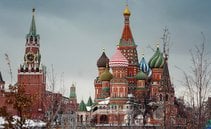Real wages are rising rapidly thanks to very dynamic labor market conditions; at the same time, unemployment is at 2.8%, the post-Soviet record low.

The outbreak of the war in Ukraine radically changed the economy of Russia. Not only because Moscow, following the military operation against Kyiv, was cut off from commercial relations with the West, but also because Vladimir Putin was forced to find new partners with whom trade in an attempt to nullify the effect of the international sanctions that have hit the Kremlin in a barrage.
This is how the Russian government began to invest massively in its military industrial sector – to support, obviously, the army’s effort on Ukrainian territory – but also in other sectors. It would be simplistic to turn the spotlight only on Moscow’s "war economy", given that Putin also launched the "National Projects 2.0" plan in 2021 with the clear objective of also investing in the civil economy, improving the daily life of Russian citizens and increase Russia’s competitiveness in the global market.
The so-called Putinomics, the economy directed by Putin, has therefore changed radically compared to the past, when it was mostly based on two pillars: the accumulation of enormous reserves (which exceeded 600 billion dollars before the war) and keeping debt ridiculously low. The time of austerity is over. Following the outbreak of war, Moscow began running a budget deficit for the first time in two decades and began spending heavily.
Financing of state fixed investments has taken place and is taking place through the issuance of OFZ Treasury bonds of the Ministry of Finance to “friendly investors” or through the use of the gigantic liquidity pool of 19 trillion rubles in the sector of national banking.
The new Putinomics
The war in Ukraine is paradoxically turning into an advantage for the Russians, at least from an economic point of view.
The Despair Index, which measures the level of desperation in emerging countries during times of crisis, Russia reached a record-high score of 19.7 in March. This index, created by the website bne Intellinews, takes into account factors such as inflation, unemployment, and poverty. Ukraine, however, achieved a near-record negative score of 61.3 during the same period.
In 2023, Reuters reported, the Kremlin’s economy began to prosper when Putin put Russia on a war footing, and when all these indicators fell sharply. Inflation is still high, but in April it was 7.8% and appeared much more manageable than in the past. Poverty has also fallen to 9.3% and is expected to fall further, going below 8% as part of the renewed and aforementioned National Projects program.
And it doesn’t end here because the economy is growing strongly and real wages are increasing rapidly thanks to the very dynamic conditions of the labor market; at the same time, unemployment is at 2.8%, the post-Soviet record low.
For the record, according to the latest data from the World Bank, the Russian economy has overtaken Japan to become the fourth largest economy in the world in terms of purchasing power parity (PPP), behind China, the United States, and India.
How is Moscow’s economy doing
Among other innovations, Putin proposed introducing a system of progressive income tax rates, which would incentivize companies to invest in the development and implementation of infrastructure and social projects, as well as extending the planning period of budget for three to six years to improve long-term planning of state finances.
As Foreign Policy explained, Russia’s relative economic success appears to be the result of the decision to orient the Russian economy towards military support, in a plot that could intensify under the new Defense Minister Andrei Belousov.
Be careful though, because The Moscow Times reported that the pace of inflation increased in May, while some Russian officials pointed out that the enormous public spending to support the military offensive against Ukraine is overheating the national economy.
Increased government spending, in particular, has supported the Russian economy despite a barrage of Western sanctions, but has also triggered a price surge and labor shortages in many sectors unrelated to the countryside.
In May, inflation was at 8.3% year-on-year, the highest rate since February 2023, and up from 7.8% at the end of April and well above the official target of inflation in the country of 4.0%. Rapid price increases have put pressure on the Russian Central Bank and the possibility that it will raise interest rates to keep inflation under control.
Last week the Bank itself raised its key interest rate to 16%, but said it could increase financing costs if the pace of price increases does not slow down.
Original article published on Money.it Italy 2024-07-02 06:37:00. Original title: La Putinomics spicca il volo: come è cambiato il modello economico della Russia





